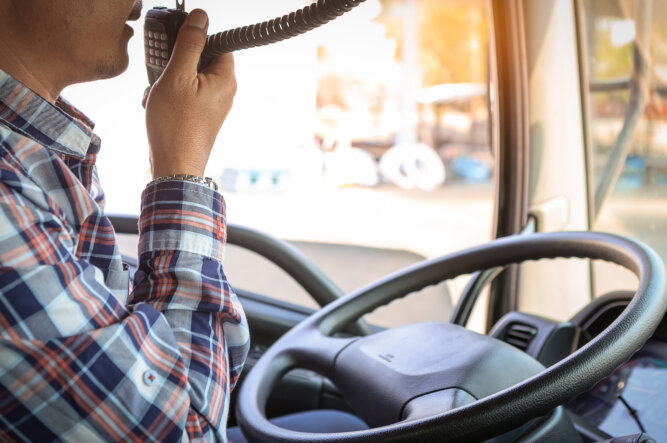An Emergency Response Guide for Brake Fires

Find your next load
Make more money starting now.
Truck safety is a top priority for drivers. And they face a multitude of safety concerns, from meticulous pre-trip inspections of every inch of their rig to ensuring cargo is securely fastened to prevent shifting during travel. But few are as essential as brake safety. With the heavy loads truckers haul, proper brake maintenance and quick responses to faulty or damaged brakes are essential to the safety of everybody on the road.
Brake fires are one particularly dangerous result of poor or incomplete brake maintenance. Caused by the buildup of grease or other flammable fluids on the brakes plus the incredible amount of heat generated by the truck as it drives down the road, brake fires put the truck, the driver, and other motorists at risk. Excess grease or fluids are often applied during brake installations or tire changes, and the good news is that careful maintenance and frequent cleaning of the brakes can help prevent dangerous brake fires.
If you smell burning or a strong chemical odor or see smoke coming from any of the wheels, it might be a brake fire—and you need to take immediate action. Learn essential safety tips and the best actions to take in case of an emergency.
Immediate Actions
Staying calm and collected is crucial to avoid having the situation escalate. A fire is incredibly stressful and frightening, but panicking worsens a bad situation. Evaluate the situation and respond with urgency, not fear.
As soon as you identify or even suspect a brake fire, activate your hazard lights to signal to other drivers of a potential problem, and turn on your signal in preparation for finding a place to pull over.
Pull Over Safely
Get off the road as soon as possible to do so safely—continuing to drive with an active fire on your vehicle is dangerous to you and other drivers.
Suitable locations for pulling over include wide shoulders or emergency pull-off areas. Ensure you have enough space to put out the fire as far away as possible from other motorists. Avoid stopping in curves or blind spots that make it difficult for other drivers to see you.
When you can’t brake, look for an emergency ramp to avoid causing an accident. These allow your truck to stop gradually. Be aware that emergency ramps have risks, like spreading fire or causing the truck to overturn. Assess the situation to make the safest decision.
Exit the Cab
Bring the rig to a complete stop, engage the parking brake, and switch off the engine. Once it’s safe to exit the vehicle, step out carefully and stay clear of traffic. If the fire is on a front wheel, get out of the truck on the opposite side of the fire. Grab your phone before exiting the cab so you can call for help.
Once you’re out of the truck, avoid standing downhill or upwind from the fire, minimizing the potential for smoke inhalation.
Call Emergency Services and Dispatch
Once you’re safe, call emergency services. Give the operator your location and as much information about the fire and truck as possible so that the first responders who come to help you can be as prepared as possible.
After calling emergency responders, inform your company dispatch of the situation. Tell them what happened, where you are, and how long you expect to be delayed. That way, they can communicate with the receiver, letting them know the load will be late.
Manage the Fire
While waiting for emergency services to arrive, use a fire extinguisher to attempt to put out the fire or at least keep the fire from spreading. You should only take this action if it is safe. Aim the fire extinguisher at the base of the flames and do not open the wheel hubs at any point; doing so can introduce more oxygen into the fire and worsen it.
Document the Scene
Document the incident as thoroughly as possible. Take photos at a safe distance before, during, and after firefighting efforts.
When the scene is safe, thoroughly inspect and continue documenting the damage. Keep an eye out for anything that might give clues about the cause, whether it’s something you see yourself or something the emergency personnel tell you about. Be sure to note each damage point’s location, size, severity, and any potential explanations.
Post-Incident Procedures
Inspect the entire braking system after the fire is out, and the danger has passed. Check for signs of damage to the brakes or other malfunctions that could compromise the truck’s safety. Wait to drive the truck again until it is safe. Be sure to report all of the inspection findings to maintenance so you can plan for repairs.
Training and Preparedness
As with any aspect of trucking, being properly trained and prepared goes a long way when dealing with brake fire emergencies. You must always be up-to-date on best practices and familiar with all emergency procedures and protocols. When an emergency occurs, being prepared helps you to remain calm and alert, allowing you to better focus on the steps needed to resolve the situation safely.
All trucking companies and owner-operators should regularly simulate brake fire scenarios to give drivers practical experience in responding to this type of emergency. Going through the process of resolving an emergency before it occurs means that in the unfortunate event that you experience a real brake fire, safely and efficiently dealing with the situation will be second nature.

Find out how our platform gives you the visibility you need to get more done.
Get helpful content delivered to your inbox.
Schedule a demo.
Find out how our platform gives you the visibility you need to get more done.





